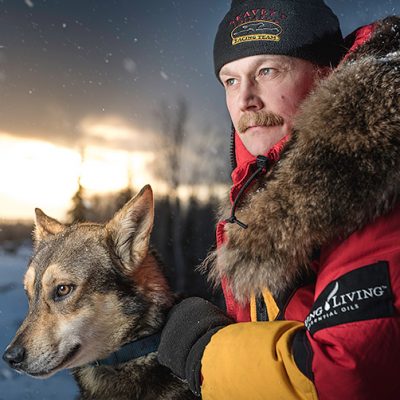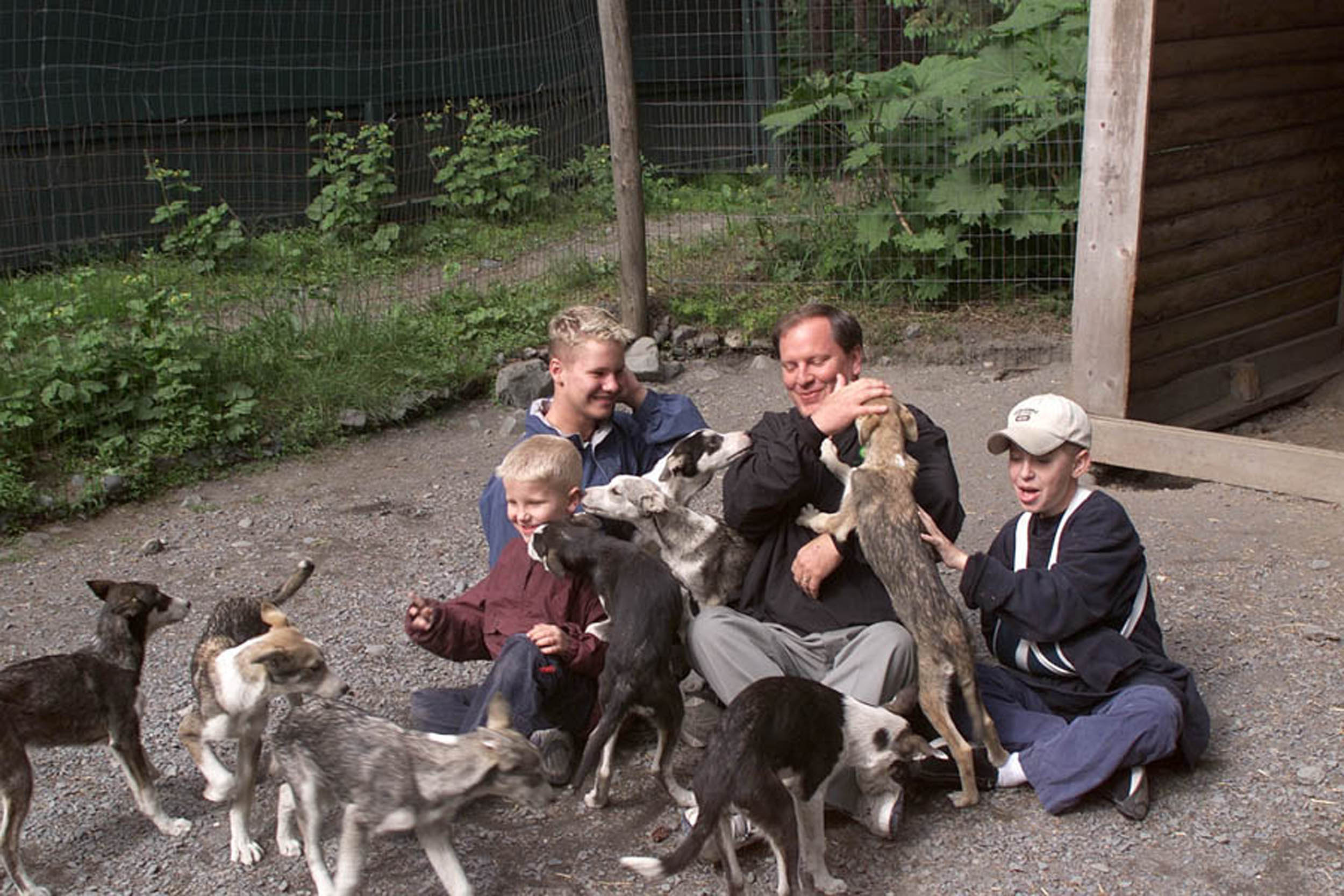One way of maximizing your Alaska mushing adventure fun is learning some dogsledding 101 basics. Here’s a primer on the pups, dogsledding races, famous mushers and dogsledding commands that make Alaska dogsledding so fascinating and fun.
Breeds of Sled Dogs
Over the years, practically every breed of dog with four functioning legs and a knack for pulling has been harnessed up to a sled in Alaska. There was even once an infamous pack of poodles that competed in the iconic Iditarod Trail Sled Dog Race. A rule was instituted shortly after incident, however, that ensures only Arctic acclimated breeds like Siberian huskies and Alaskan malamutes were permitted in the race, along with other dogs that are favored in the most grueling distance races. Smaller breeds that are mixed from those, like Alaskan huskies, are among the most popular for multi-stage races that specialize in speed over shorter distances.

Alaskan children with sled dog puppies.
Famous Sled Dogs
Yes, some Alaska sled dogs are actually famous. The biggest star is Balto, an Alaskan husky that led Leonhard Seppala on the legendary last leg of the Serum Run from Anchorage to Nome in 1925. (The run was the inspiration for the Iditarod many years later.) Balto was so famous, he retired to the Cleveland Zoo and has statues in Central Park in New York City and in the heart of downtown Anchorage. Balto even had an animated movie made in his honor.

Source: Case Western Reserve
Some argue, and history even notes, that another dog from the Serum Run was the more legendary leader: Togo. While Disney made a movie named after him, his accomplishments were always overshadowed by Balto.
Around 60 years after the Serum Run, Granite became famous as the lead dog on superstar musher Susan Butcher’s Iditarod-winning teams. Granite was born as the runt of his litter, but ultimately lived up to his hard-as-a-rock name with toughness, tenacity and talent, becoming Butcher’s favorite lead dog during her dominating Iditarod run.
Dogsledding Races
Iditarod Trail Sled Dog Race
Known as “the Last Great Race”, this is Alaska’s ultimate sled dog race, packed with legend and lore, the biggest prizes, the top teams of dogs, celebrity mushers, and media and fans following around the world. The 1,000-mile race travels from Anchorage to Nome in early March and is a nod to the historic Serum Run. Alaskans and fans worldwide follow the race closely every year. For many racers, this is a marathon competition of survival and savvy at its most intense. For others, it’s a lifelong dream and accomplishment just to cross the finish line.
The Yukon Quest International Sled Dog Race
The Yukon Quest might be overshadowed by the Iditarod in fame and flash, but mushers agree it’s the tougher and more grueling race. It travels 1,000 miles between Fairbanks to Whitehorse, Canada, in the Yukon Territories, switching direction every year. The trail takes racers and their dog teams through some of the north’s coldest weather and most unforgiving terrain.
While the Iditarod and Yukon Quest are long-distance races through Alaska’s challenging conditions and wilderness, two annual spring sprint races are all about speed on urban streets and pristine trails. The Fur Rendezvous Open World Championship is an exciting three-day sprint race around Anchorage, Alaska’s largest city, while the Open North American Championships features similar speeds and multi-day format in Fairbanks.
Famous Mushers
Susan Butcher is Alaska’s most famous dog musher and among America’s most famous female athletes. She made her name, and made history, in the Iditarod, placing first four times, including four wins in five years, second another four times, and held the race’s time record from 1986-1992. Though she preferred the privacy and trials of off-the-grid frontier Alaska life, her glowing personality and magnetic smile made her a beloved figure everywhere she went, especially on the Iditarod trail. Her untimely passing from cancer at 51 secured her legacy as an Alaska legend and inspiration forever. Since 2008, the first Saturday of every March is Susan Butcher Day, which aligns with the day of the Iditarod’s annual ceremonial start.
George Attla is the Alaska Native champion sprint dog musher, known as the Huslia Hustler as a nod to his tiny hometown and his need for speed. He was a star among Alaska mushing stars in the 1970s and 80s, winning 10 Fur Rendezvous Open World Championships and eight Open North American Championships in Fairbanks. He even took a stab at the first running of the Iditarod in 1973, placing fourth. His life was captured in a movie, in books and song, and he was even honored by the State of Alaska when April 29 was declared George Attla Day.
The Seaveys are a family made famous from their Iditarod exploits and practically have Alaska dog mushing flowing in their bloodlines. Dan Seavy moved his family to Seward, Alaska, in 1963 to work a teacher and was instantly transfixed on dog mushing. He was among the founders of the Iditarod, ran the first and second races in 1973 and 1974, and remains connected to the race in many ways since. His son, Mitch, became an Iditarod champion, winning the race in 2004, 2013 and 2017. Dan’s grandson and Mitch’s son, Dallas, has the family bragging rights: winning the Iditarod five times, one of only two mushers sharing that race record. Dallas was also the youngest musher to win the Iditarod, claiming victory in the 2012 race at 25. Dallas has also won the Yukon Quest and the Finnmakslopet in Norway, Europe’s longest sled dog race, Mitch and Dallas each own popular kennels for Alaska visitors: Mitch in Seward and Dallas in Talkeetna.

Mitch Seavey

Dallas Seavey
Mushing Commands
Dog sleds don’t have steering wheels or turn signals, but the dog teams only need to hear commands barked by their drivers and they turn into fast-driving, finetuned, and sweet-handling machines.
- When a musher yells, “Gee!” the team turns right
- When a musher yells, “Haw!” the team hangs a left.
- “On by!” is a universal command many dog owners know well; for mushers, it keeps their team focused on the trail ahead instead of potential distractions.
- The often-used “Hike!” means “Go!”
- “Whoa!” is like hitting the brakes, bringing the team to a stop … or at least a slow down to a stop helped by the driver’s manual claw brake.
Wherever you mush in Alaska, you’ll never forget this experience, ever. Just remember to bring extra camera batteries because you’ll want to capture every moment you’re out cruising with your yapping team of enthusiastic partners on the trail!

Hold an Alaska husky puppy at a working sled dog kennel.
